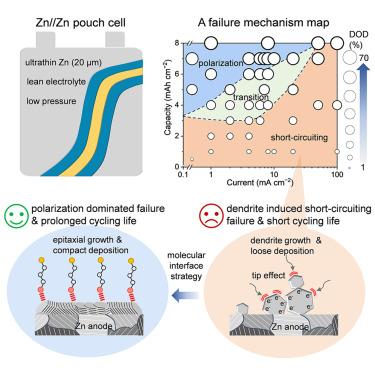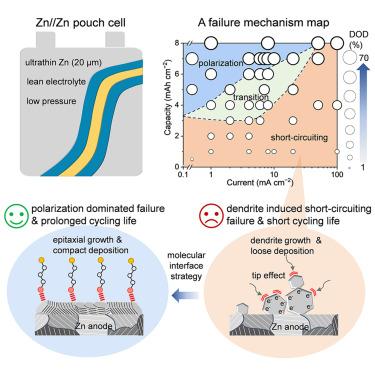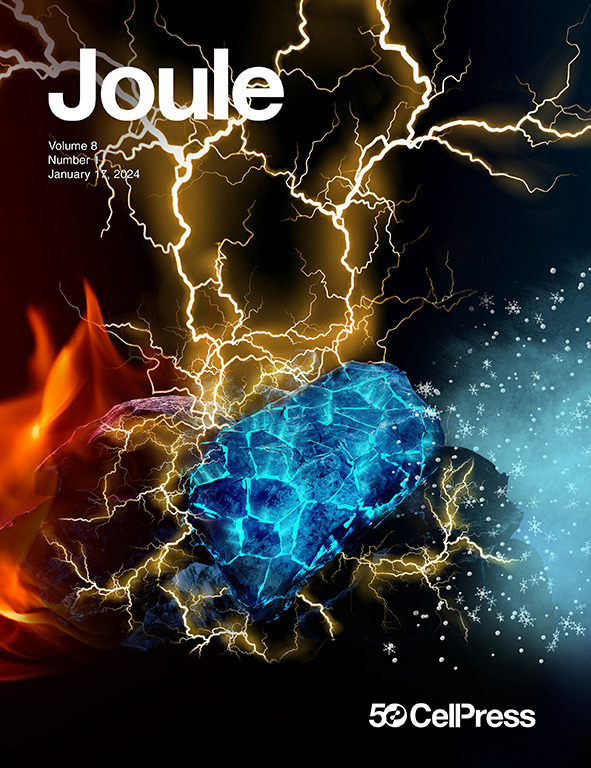Failure mechanisms and remedy of an ultrathin Zn metal anode in pouch cells
IF 38.6
1区 材料科学
Q1 CHEMISTRY, PHYSICAL
引用次数: 0
Abstract
Zinc (Zn) metal anodes have attracted much attention for their use in aqueous Zn batteries. However, their electrochemical behavior and failure mechanisms under practical conditions remain unclear, and their cycling performance is far from the target for practical use. Here, we have developed a failure mechanism map of ultrathin Zn metal anodes in practical large (49 cm2) pouch cells and divided it into three zones, i.e., polarization, short-circuiting, and transition between the two. The correlation between failure mode and depth of discharge was revealed. Moreover, to improve the durability of large Zn anodes, a molecular interfacial layer was designed to produce compact epitaxial growth of Zn. Consequently, practical Zn||I2 pouch cells with modified Zn anodes had a high capacity (∼1,200 mAh) and cycling stability (∼600 cycles), which is the record-stable Ah-level full cell reported so far. This work provides both fundamental and practical insights for accelerating the use of Zn batteries.


袋式电池中超薄锌金属阳极的失效机制和补救措施
锌(Zn)金属阳极在锌水电池中的应用备受关注。然而,它们在实际条件下的电化学行为和失效机理仍不清楚,其循环性能也远未达到实际应用的目标。在此,我们绘制了超薄锌金属阳极在实用大型(49 平方厘米)袋式电池中的失效机理图,并将其分为三个区域,即极化、短路和两者之间的过渡。研究揭示了失效模式与放电深度之间的相关性。此外,为了提高大型锌阳极的耐用性,还设计了一种分子界面层,以产生紧凑的锌外延生长。因此,采用改性锌阳极的实用 Zn||I2 袋式电池具有高容量(∼1,200 mAh)和循环稳定性(∼600 次),是迄今为止报道的最稳定的 Ah 级全电池。这项工作为加速锌电池的使用提供了基础和实用见解。
本文章由计算机程序翻译,如有差异,请以英文原文为准。
求助全文
约1分钟内获得全文
求助全文
来源期刊

Joule
Energy-General Energy
CiteScore
53.10
自引率
2.00%
发文量
198
期刊介绍:
Joule is a sister journal to Cell that focuses on research, analysis, and ideas related to sustainable energy. It aims to address the global challenge of the need for more sustainable energy solutions. Joule is a forward-looking journal that bridges disciplines and scales of energy research. It connects researchers and analysts working on scientific, technical, economic, policy, and social challenges related to sustainable energy. The journal covers a wide range of energy research, from fundamental laboratory studies on energy conversion and storage to global-level analysis. Joule aims to highlight and amplify the implications, challenges, and opportunities of novel energy research for different groups in the field.
 求助内容:
求助内容: 应助结果提醒方式:
应助结果提醒方式:


